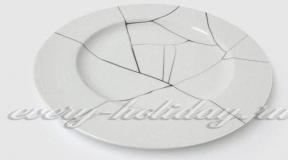There are only atoms and emptiness. Atoms and emptiness
(Democritus).
The philosopher Democritus of Abder reconciled the Eleic and Heraclitean points of view. He made a synthesis of two views. Like Heraclitus, he believed that everything in the world is in motion, changes and is divided into parts, but, following the Eleatics, he believed that only the indivisible and immutable can exist by Being. After all, Being is eternal, which follows from the concept itself, and the eternal cannot be divisible, since that which consists of parts does not always exist (if the parts are together, it exists, if they are separated, it will not be). Each thing consists of parts, Democritus believed, but each of its parts, in turn, also consists of parts, and so everything is divided as long as you like.
But if division is possible to infinity, if everything consists of parts and is divisible, then what can be called Being? Divisible is not eternal, but everything is divisible, so everything is not eternal, but Being can only be eternal, therefore, it does not exist at all. But Being cannot but be, which follows from the concept itself. Therefore, it is necessary to assume that everything is divided not to infinity, but to a certain definite limit, beyond which division is impossible. In other words, there is a certain particle, albeit very small, but further indivisible. Indivisible, it cannot be destroyed because it does not consist of parts into which it can disintegrate. It exists eternally, therefore, and is the actual basis of Being, its bearer, represents Being itself. The dividend in Greek sounds like "tomos". The negative particle in Greek is "a". Therefore, the indivisible is "atomos" or "atom". This word, as we see, first used Democritus, and for two thousand years it has existed in all Western languages.
Of course, the atom in the modern sense is not the atom of Democritus at all. Today, this term denotes an element of matter that is too small, but by no means indivisible: we know that an atom consists of elementary particles and has a complex structure. In Democritus, the atom is necessarily indivisible and therefore eternal, that which can be considered as genuine Being. After all, the only property of the atom is always to be. Even if he wanted not to be, he could not do it. The atom (indivisible) is doomed to immutable existence, to Being. Democritus in his doctrine of the constant basis of all things - the atom (a particle of the universe, eternal, indivisible and unchanging) - shares the views of the Eleatic philosophers.
However, following Heraclitus, he believed the world to be eternally changing. Since, as Democritus argued, there are infinitely many atoms, they move in emptiness and, colliding, unite, exist together for some time, then, under the influence of new collisions, they separate and move again, interacting with each other. The union of atoms leads to the birth of things, separation - to their destruction. All objects, thus, arise and are destroyed, and the world represents eternal movement and change. All things are completely different, but at the same time they are, by and large, one and the same, because they consist of the same atoms. World diversity is reduced to one basis - atoms moving in emptiness. As for the diversity of the universe, Thales has a single origin - water, and Anaximenes has air, Pythagoras has a number, so Democritus has atoms. Why are things different from each other if they are made of the same material? Because the atoms from which they are formed are connected in each thing in different ways and in different proportions.
Any object is only a temporary combination of indivisible particles and exists only as long as they are together. Things either exist or do not, and therefore are not real Being, in other words, they, in a large measure, do not exist, but only what they consist of - a set of unchanging atoms. In the same way, the properties of things exist temporarily: there is no thing, there are no properties of it either. Thus, they, by and large, do not exist either, since they are only products of atomic combinations. Everything that we see around us, says Democritus, is not really real reality... Behind the inauthentic world that surrounds us, there is a real, but invisible to us world of atoms and emptiness. He is truly existing, and everything that we perceive sensually is just his creation, and therefore ephemerality, phantom, mirage, illusion. There are no mountains, no heavenly bodies, no water, no earth, no air, no plants and animals, says the Abdera thinker, there is no cold, no warm, no sweet, no salty, no white, no green, there is nothing at all, but it only seems to us that all this is. Only atoms and emptiness really exist.
To illustrate the atomistic picture of the world of Democritus, let us give an analogy. Everyone is well aware of one of the types of fine art - mosaic: from a set of colored glasses or chips, you can make one pattern or ornament or another, various combinations. Let's make some picture out of them, then break it down, build another, and so on. Do all these drawings really exist? No, they do not exist, they are only a possibility. And what really exists? Only this set of mosaic glasses and nothing else! So the universe, according to Democritus, is not things and their properties, but only the sum of atoms, which is the only reality.
Quantum Computing Since Democritus / Scott Aaronson; Per. from English. - M .: Alpina non-fiction, 2018.
I would rather find one causal explanation than become king of the Persians.
DEMOCRITE
And yet why Democritus? Let's start from the very beginning: who is Democritus? Some ancient greek dude. He was born sometime around 450 BC. e. in that same boring provincial Greek town called Abdera, about which the Athenians said that the very air in it breeds stupidity. According to my source, Wikipedia, he was a student of Leucippus. He is called a pre-Socrat, although in fact he was a contemporary of Socrates. This gives some idea of \u200b\u200bwhat importance is attached to it: "Well, yes, pre-Socratics ... maybe it is worth mentioning them in the first lecture of the course." By the way, there is a legend that Democritus once visited Athens specifically to meet Socrates, but when he met him he simply did not dare to give his name.
Almost nothing of the works of Democritus has come down to us. Something remained even before the Middle Ages inclusive, but by now it has been lost. We receive information about him mainly from other philosophers (for example, from Aristotle), who mention Democritus in order to criticize him.
What are they criticizing? Democritus believed that the entire universe consists of atoms in emptiness, which continuously move according to well-defined and understandable laws. These atoms can collide with each other and bounce when they collide, or they can stick together into larger objects. They can be of different sizes, weights and shapes - maybe some are spheres, some are cylinders, and some are something else. On the other hand, Democritus claims that the properties of things, such as color and taste, are not determined by the properties of atoms, but arise from the interaction of many atoms. For if the atoms that make up the oceans were "inherently blue," how could they form white foam at the tops of the waves?
Remember, this is about 400 BC. e. So far, everything is very good.
Why does Democritus think that all things are made of atoms? He gives some arguments, one of which can be formulated in his own words as follows: suppose we have an apple, and suppose that this apple is not made of atoms, but of something continuous and solid. Suppose further that we take a knife and cut the apple in two. Clearly, points on one side will fall on the first piece, and points on the other side will fall on the second, but what about points located exactly on the border? Are they going to disappear? Or will it double? Will the symmetry be broken? None of these features seem particularly elegant.
By the way, fierce disputes between atomists and antiatomists continue today. The question of whether space and time themselves actually consist of indivisible atoms on Planck scales of 10−33 cm or 10−43 s is discussed. Again, physicists have very little experimental data to rely on in this matter, and they are, in essence, in the same position as Democritus was 2400 years ago. If you want to know the opinion of an ignorant and not too informed layman on this score, then I would bet on the atomists. And the arguments that I would use in this case are not completely different from those used by Democritus: they, again, are based mainly on the unavoidable mathematical difficulties with the continuum.
One of the few passages of Democritus that have come down to us, is a dialogue between Reason and Feelings. The mind starts a conversation: "Only by agreement between people does sweetness exist, by agreement - bitterness, by agreement - color, in fact there are only atoms and emptiness." For me, this one line already puts Democritus on a par with Plato, Aristotle and any other ancient philosopher whom you dare to name: it would be difficult to formulate more precisely in one sentence everything scientific outlook, which will appear in 2000 years! But the dialogue doesn't end there. The senses answer: “Foolish Reason! Are you trying to overthrow us, although it is from us that you receive all the data? "
I first met this dialogue in a book by Schrödinger. Aha, Schrödinger! - you see, we are slowly moving towards the "quantum computing" declared in the title of the book. Don't worry, we will definitely get to them.
But why should Schrödinger be interested in this dialogue? Well, actually he was interested in a lot of things. He was not prone to intellectual monogamy (and indeed to no other monogamy either). But one of the possible reasons for his interest is the fact that he was one of the founders of quantum mechanics - the most amazing discovery, in my opinion, of the 20th century (followed by the theory of relativity by a small margin) - and a theory that added a completely new aspect to a thousand-year dispute between reason and feelings, although she could not resolve it.
This is what it is about: for any isolated area of \u200b\u200bthe Universe that we want to consider, quantum mechanics describes the evolution in time of the state of this area, which we represent as a linear combination - a superposition - of all possible configurations of elementary particles in this area. Thus, this is a very extravagant picture of reality, in which each particular particle is not here and not there, but in a kind of weighted sum of all the places in which it could be. At the same time, the theory works. As we all know, it describes very well the “atoms and emptiness” that Democritus spoke about.
She also has her own difficulties. Not very good, say, is the case with reliable data supplied by the senses. What is the problem? Well, if you take quantum mechanics seriously, it turns out that you yourself should, in theory, be in a superposition of different places at the same time. After all, you too are made of elementary particles, right? Imagine, in particular, that you are considering a certain particle that is located in a superposition of two positions - A and B. In this case, the most naive and literal reading of quantum mechanics would predict that our Universe should split into two "branches": in one the particle is in A and you see it in A, and in the other - the particle is in B and, accordingly, you see it in B! And what do you think: do you really split into multiple copies of yourself every time you look at something? I personally don't feel anything like that!
You may be wondering how such a crazy theory can be useful to physicists at the most practical level. How can she even make predictions if she says, in essence, that everything that could happen is really happening? Well, I have not yet told you that there is a separate rule for what happens at the moment when you take a measurement - an external rule, "attached", so to speak, to the equations themselves in addition. This rule basically says that your look at a particle forces it to decide where it wants to be, and that the particle makes its choice probabilistically. Next, the rule tells you exactly how these probabilities should be calculated. And, of course, the calculation is perfectly and convincingly confirmed.
But here's the problem: the universe is living for itself on the sly, minding its own business, and how do we know when to apply this rule of measurement, and when not? And in general, what is considered a "measurement"? It is hard to imagine that the laws of physics would say: "This and that happens until someone looks, and then something completely different happens!" It is assumed that the laws of nature are universal. They are supposed to describe human beings in exactly the same way as supernovae and quasars: simply as huge and complex assemblies of particles interacting according to simple rules.
Thus, from the point of view of physics, everything would be much simpler and more understandable if we could get rid of all this hassle with "measurements" at all! Then we could say, paraphrasing Democritus in today's fashion: there is nothing but atoms and emptiness, developing in a quantum superposition.
But wait, if we are not poking our noses with measurements and nothing violates the primordial beauty of quantum mechanics, then how could “we” (whatever this pronoun mean) at all get any evidence that quantum mechanics correctly reflects reality? Why did we all unanimously believe in this theory, which seems to be greatly hampered by the very fact of our existence?
This is what the modern version of the democritical dilemma looks like, which physicists and philosophers have been arguing about for almost a hundred years. I confess frankly: we will not solve it in this book.
And one more thing that I am not going to do in this book: I will not impose on you any of my favorite "interpretation" of quantum mechanics. You are free to stick to the interpretation that your conscience tells you to believe. (What views do I hold myself? Well, I agree with each interpretation insofar as it claims a problem exists, and I disagree with it insofar as it claims to have solved the problem!)
You see, just as religions can be divided into monotheistic and polytheistic, interpretations of quantum mechanics can be classified according to the way they approach the question of "putting oneself in a coherent superposition." On the one hand, we have interpretations that, with great enthusiasm, sweep this question under the carpet: the Copenhagen interpretation and its grandchildren, the Bayesian and epistemological interpretations. They contain, of course, both a quantum system and a measuring device, but there is always a line between them. Of course, the line can shift and occupy different positions in different experiments, but in every experiment it is certainly present. In principle, you can even mentally put other people on the quantum side of this line, but you yourself always remain on the classical side. Why? Because a quantum state is just a representation of your knowledge, and you, by definition, are a classical being.
But what if you want to apply quantum mechanics to the entire universe, including yourself? In epistemological interpretations, the answer is simply that such questions are not accepted! Incidentally, this was Bohr's favorite philosophical move, his killer argument: "You cannot ask such a question!"
On the other side we have interpretations that nevertheless try to deal with the problem of putting oneself in a superposition in various ways: many-worlds interpretations, Bohm's mechanics, etc.
To stubborn problem solvers like us, this may all seem like just a grand argument over words - why should we care? And I’m ready to agree with this: if it was really a dispute about words, then there would be no difference, and we should not worry about it! But as pointed out in the late 1970s. David Deutsch, we are in a position to come up with experiments that would distinguish the first and second types of interpretations. The simplest experiment of this kind would be to put yourself in a state of coherent superposition and see what happens! Or, if it is too dangerous, put someone else in a coherent superposition. The idea is that if human beings were regularly placed in a superposition position, then the question of drawing a line separating "classical observers" from the rest of the universe would be meaningless.
But okay, the human brain is a watery, loose, sloppy thing, and we might not have been able to keep it in a coherent superposition for 500 million years. What can replace this experiment? Well, we could put the computer in a superposition state. The more complex the computer - the more it resembles the brain and ourselves, the further we can push the very “line” between the quantum and the classical. As you can see, there is only one tiny step left from that to the idea of \u200b\u200bquantum computing.
I would like to draw a more general lesson from all this. What is the point of starting a conversation about philosophical questions? The fact is that in the future we are going to be quite actively engaged in this - in the sense of empty philosophical chatter. On this score, there is a standard answer: philosophy, they say, is engaged in intellectual clearing, these are cleaners who come after physicists and try to put things in order by sorting out the trash left by them. According to this concept, philosophers sit in their chairs and wait for something interesting to appear in physics or in science in general - quantum mechanics, say, or Bell's inequalities, or Gödel's theorem; after that, they (let's give a metaphor with the opposite sign) flock to the novelty, like vultures, and announce: ah, that's what it really means.
Well, at first glance, it all seems kind of boring. But when you get used to this kind of work, it seems to me that you discover that it is ... boring anyway!
Personally, I am primarily interested in the result - the search for solutions to non-trivial, well-defined and still unsolved problems. What is the role of philosophy here? I would like to suggest a more interesting and sublime role for philosophy than that of an intellectual janitor: philosophy can be a scout. She could be a pioneering explorer - mapping the intellectual landscape that physics would later inhabit. Not all areas of the natural sciences were surveyed by philosophy in advance, but some were. And in recent history, I think quantum computing can serve as a reference example. It's great, of course, to tell people, "Shut up and count," but the question is what exactly they should count. At least in quantum computing (my specialty) what we like to count - the capacity of quantum channels, the probabilities of errors in quantum algorithms - these are things that no one would have thought of counting if it were not for philosophy.
Atoms and emptiness
According to Democritus, the Universe is a moving matter, atoms of substances (being - to on, to den) and emptiness (to uden, to meden); the latter is as real as being (see 13, 146; 173; 189, etc.). Eternally moving atoms, connecting, create all things, their separation leads to the death and destruction of the latter. The system of Democritus, like other ancient Greek philosophical teachings, were characterized by dialectical features. Lenin saw an element of dialectics in the very distinction between atoms and emptiness. In his opinion, Hegel, expounding the teachings of Leucippus, caught the "grain of truth": in atomistics there is "a shade (" moment ") of separateness; interruption of gradualness; the moment of smoothing out contradictions; interruption of the continuous, atom, unit ... "Unit and continuity are opposites" ... "(3, 29, 238).
The introduction by atomists of the concept of emptiness as non-being had a deep philosophical meaning... The category of non-being made it possible to explain the emergence and change of things. True, in Democritus, being and non-being coexisted side by side, separately: the atoms were carriers of plurality, while emptiness embodied unity; this was the metaphysical nature of the theory. Aristotle tried to overcome it, pointing out that we see “the same continuous body, sometimes liquid, sometimes solidified,” therefore, a change in quality is not only a simple connection and separation (13, 239). But at the level of science contemporary to him, he could not give a proper explanation for this, while Democritus convincingly argued that the reason for this phenomenon was a change in the amount of interatomic emptiness.
The concept of emptiness led to the concept of spatial infinity. The metaphysical feature of ancient atomistics also manifested itself in the understanding of this infinity as an endless quantitative accumulation or decrease, connection or separation of permanent "bricks" of being. However, this does not mean that Democritus generally denied qualitative transformations, on the contrary, they played a huge role in his picture of the world. Whole worlds are transformed into others. Separate things are also transformed, for eternal atoms cannot disappear without a trace, they give rise to new things. The transformation occurs as a result of the destruction of the old whole, the separation of atoms, which then make up a new whole (ibid., 343; 344). According to Democritus, atoms are indivisible (atomos - "indivisible"), they are absolutely dense and have no physical parts. But in all bodies they are combined so that at least a minimum amount of emptiness remains between them; the consistency of bodies depends on these spaces between atoms.
In addition to the signs of Elean being, atoms have the properties of the Pythagorean "limit" (see 64, 173). Each atom is finite, limited to a certain surface and has an invariable geometric shape. On the contrary, emptiness, as "unlimited", is not limited by anything and is devoid of the most important sign of true being - form. Atoms are not sensuously perceptible. They look like specks of dust floating in the air, and are invisible due to their too small size, until a ray of the sun falls on them through the window into the room. But atoms are much smaller than these grains of dust (see 13, 200-203); only a ray of thought, reason can reveal their existence. They are also imperceptible because they do not have the usual sensory qualities - color, smell, taste, etc.
Simplicius clearly tells us that “the Pythagoreans and Democritus, not without reason, while searching for the causes of sensual qualities, came to the forms ( that is, to atoms) " (schemata), which Democritus sometimes also called the Abdera words rysmoi - "figures" or ideai - "ideas", "species" (ibid., 171. See also CXV; CXVI; 198), emphasizing their main distinguishing feature. The reduction of the structure of matter to more elementary and qualitatively homogeneous physical units than the "elements", "four roots" and partly even the "seeds" of Anaxagoras, was of great importance in the history of science.
How, however, do the atoms of Democritus differ from each other?
Studying the testimony of Theophrastus, a disciple of Aristotle, whose comments served as the primary source of many later reports on the philosophy of the Greek pre-Socratics, including Democritus, the English scholar Mac Diarmid noted a certain contradiction. In some places it comes only about the difference in the forms of atoms, in others - also about the difference in their order and position (see 80, 124; 125). However, it is not difficult to understand: the order and position (rotation) can differ not single atoms, but composite bodies, or groups of atoms, in one composite body. Such groups of atoms can be located up or down (position), as well as in a different order (like the letters HA and AH), which modifies the body, makes it different (see 13, 238-248). And although Democritus could not predict the laws of modern biochemistry, but it is from this science that we know that, indeed, the dissimilarity of two organic substances of the same composition, for example, two polysaccharides, depends on the order in which their molecules are arranged. The huge variety of protein substances depends mainly on the order of amino acids in their molecules, and the number of possible combinations when combining them is practically infinite. The fundamental particles of matter, the existence of which Democritus assumed, combined in themselves to some extent the properties of an atom, a molecule, a microparticle, a chemical element and some more complex compounds.
The atoms also differed in size, on which, in turn, the severity depended. As you know, the conjecture about the atomic weight belongs to Epicurus. However, Democritus was already on the way to this concept, recognizing the relative weight of atoms, which, depending on their size, are heavier or lighter. For example, he considered the smallest and smoothest spherical atoms of fire that make up the air, as well as the human soul, to be the lightest atoms.
The question of the so-called amers, or "mathematical atomism" of Democritus is connected with the shape and size of atoms. Row ancient Greek philosophers (Pythagoreans, Eleians, Anaxagoras, Leucippus) were engaged in mathematical research. Democritus was undoubtedly an outstanding mathematical mind. However, Democritus mathematics differed from the generally accepted one. According to Aristotle, she “shook mathematics” (13, 108). It was based on atomistic concepts. Agreeing with Zeno that the divisibility of space to infinity leads to absurdity, to the transformation into zero quantities, from which nothing can be built, Democritus discovered his indivisible atoms. But the physical atom did not coincide with the mathematical point. According to Democritus, atoms had different sizes and shapes, shapes, some were larger, others smaller. He assumed that there are hook-shaped, anchor-shaped, rough, angular, curved atoms - otherwise they would not adhere to each other (see ibid., 226; 227; 230; 233). Democritus believed that atoms are indivisible physically, but mentally parts can be distinguished in them - points that, of course, cannot be rejected, they do not have their own weight, but they are also extended. This is not zero, but the minimum value, further indivisible, the mental part of the atom - "amera" (unhappy) (ibid., 120; 124). According to some testimonies (among them there is a description of the so-called "Democritus square" by Giordano Bruno), the smallest atom had 7 amers: top, bottom, left, right, front, back, middle. It was mathematics, consistent with the data of sensory perception, which said that no matter how small a physical body - for example, an invisible atom - such parts (sides) in it can always be imagined, it is impossible to divide it to infinity even mentally.
From extended points, Democritus made extended lines, of which - planes. A cone, for example, according to Democritus, consists of the thinnest, sensually imperceptible circles, parallel to the base, because of their subtlety. So, by folding the lines, accompanied by a proof (see ibid., XIV), Democritus discovered the theorem about the volume of a cone, which is equal to a third of the volume of a cylinder with the same base and equal height; he also calculated the volume of the pyramid. Both discoveries were recognized (and already substantiated differently) by Archimedes (see 49 and 23, 35-41).
The authors reporting on the views of Democritus had little understanding of his mathematics. Aristotle and subsequent mathematicians rejected it sharply, so it was forgotten. Some modern researchers deny the difference between atoms and amers in Democritus, or believe that Democritus considered atoms indivisible both physically and theoretically (see 73); but the latter point of view leads to too many contradictions. Atomistic theory mathematics existed, and it was subsequently revived in the school of Epicurus.
Atoms are infinite in number, the number of configurations of atoms is also infinite (diverse), "since there is no reason why they would be more like that than others" (13, 147). This principle (“no more so than otherwise”), which is sometimes called in the literature the principle of indifference or heterogeneity, is characteristic of the Democritian explanation of the Universe. With its help it was possible to substantiate the infinity of motion, space and time. According to Democritus, the existence of countless atomic forms determines an infinite variety of directions and speeds of the primary motions of atoms, and this, in turn, leads them to encounters and collisions. Thus, all world formation is deterministic and is a natural consequence of the perpetual motion of matter.
Ionian philosophers have already spoken about perpetual motion. However, this view was still associated with hylozoism. The world is in perpetual motion, for in their understanding it is a living being. Democritus decides the question completely differently. Its atoms are not animate (the atoms of the soul are them only in connection with the body of an animal or a person). Perpetual motion is the collision, repulsion, cohesion, separation, movement and fall of atoms caused by the initial vortex. Moreover, atoms have their own, primary motion, not caused by jolts: "shake in all directions" or "vibrate" (see ibid., Commentary to 311). The latter concept has not been developed; he was not noticed by Epicurus when he corrected the Democritian theory of the motion of atoms by introducing an arbitrary deviation of atoms from a straight line.
In his picture of the structure of matter, Democritus also proceeded from the principle put forward by previous philosophy (formulated by Melissus and repeated by Anaxagoras) - the principle of the preservation of being: "nothing arises from nothing." He connected it with the eternity of time and motion, which meant a certain understanding of the unity of matter (atoms) and the forms of its existence. And if the Eleans believed that this principle applies only to the intelligible "truly existing", then Democritus attributed it to the real, objectively the existing world, nature.
The atomic picture of the world seems simple, but it is grandiose. The hypothesis about the atomic structure of matter was the most scientific in its principles and the most convincing of all, created by philosophers earlier. She brushed aside in the most decisive way the bulk of religious and mythological ideas about the supernatural world, about the intervention of the gods. In addition, the picture of the motion of atoms in the world void, their collision and cohesion is the simplest model of causal interaction. The determinism of the atomists became the antipode of Plato's teleology. The Democritical picture of the world is already a pronounced materialism, such a philosophical explanation of the world was in the conditions of antiquity as opposed to mythological as possible.
From the book of the Tao of Physics author Capra FridtjofChapter 14. EMPTY AND FORM Classical mechanics proceeded from the concept of solid and indivisible particles moving in emptiness. Modern physics has revised this picture in the most dramatic way, significantly changing our views not only on particles, but also on emptiness.
From the book Six Systems of Indian Philosophy author Müller MaxANU (ATOMS) The theory of atoms (anu) is considered original for Canada, it is even considered hallmark his philosophical system... Anu in his system is replaced by the tanmatras of the Samkhya philosophy. Although the idea of \u200b\u200batoms was also known to the philosophy of Nyaya (Nyaya Sutras, IV, 2, 4-25), but quite
From the book Conversations with Krishnamurti author Jiddu KrishnamurtiInner Emptiness She carried a large basket on her head, supporting it with one hand. She must have been quite heavy, but the weight did not change the rhythmic swaying of her step. The gait was graceful, light, and flowing. There were large metal bracelets on his arm,
From the book Short story philosophy [Not boring book] author Gusev Dmitry Alekseevich2.7. Things and Atoms (Democritus) We already know that the first Greek philosophers considered the details of the surrounding world visible to us not to be genuine reality, but to be the products or forms of a single invisible principle. Thales had such a beginning with the world substance - water,
From the book Lovers of Wisdom [What You Should Know modern man about history philosophical thought] author Gusev Dmitry AlekseevichDemocritus. Things and Atoms We already know that the first Greek philosophers considered the details of the surrounding world visible to us not to be genuine reality, but to be the products or forms of a single invisible principle. Thales had such an origin of the world substance - water, Anaximenes -
From the book of Stratagems. About the Chinese art of living and surviving. TT. 12 author von Senger Harro From the book Popular Philosophy author Gusev Dmitry Alekseevich§ 12. "Only atoms and emptiness ..." (Democritus) The philosopher Democritus of Abder reconciled the Eleic and Heraclitean points of view. He made a synthesis of two views. Like Heraclitus, he believed that everything in the world is in motion, changes and is divided into parts, but, following
From the book by Carlos Castaneda. Shattered Knowledge author Dzheldashov VasilyImage 1. Emptiness "Why does emptiness prevent you from seeing the template? The nagual said that everything in the world is force, attraction or repulsion. In order to be repelled or attracted, we must be like a sail or a kite in the wind. But if there is a hole in our luminosity, the power
From the book Comments to Life. Book three author Jiddu KrishnamurtiInner Emptiness She carried a large basket on her head, supporting it with one hand. She must have been quite heavy, but the rhythmic swaying of her gait was unaffected by the weight. She kept her balance beautifully, her gait was light and smooth. On her hand were
From the book Fiery Feat. part II author Uranov Nikolay AlexandrovichIS THERE EMPTY? A false concept lives in the human consciousness - EMPTINESS, which is often associated with NON-BEING. "Like smoke disappear" is sung in a church chant. The man died, "gave up his ghost," and this spirit sank into oblivion, into emptiness. But all life is FIRE. Fire
From the book The Doctrine of Being author Hegel Georg Wilhelm Friedrichb. One and emptiness One is emptiness, as an abstract relation of denial to oneself. But from empty immediacy, from such being of one, which is also affirmative, emptiness differs as simple nothing; and since they are in a relationship, precisely in one thing, then
From the book What Do We Live For? [View from the perspective of subjective realism] author Zakharov Konstantin ValerievichMatter and emptiness The world appears before us as a continuous series of phenomena replacing each other, behind which a single changeable essence is guessed. Unity follows from the fact that all phenomena, despite their apparent diversity, converge at one point, which
From the book Amazing Philosophy author Gusev Dmitry AlekseevichThings and atoms. Democritus We already know that the first Greek philosophers considered the details of the surrounding world visible to us not to be the true reality, but to be the products or forms of a single invisible principle. Thales had such an origin of the world substance - water, Anaximenes -
From the book From early works (1835 - 1844) author Engels FriedrichChapter three. Atoms-beginnings and atoms-elements In his aforementioned article on the astronomical concepts of Epicurus Schaubach says: “Epicurus, together with Aristotle, distinguished between the beginnings (?????? ?????, Diogenes Laertius, X, 41) and the elements ( ????? ????????, Diogenes Laertius, X, 86). The first
From the book Dreams of Warriors of the Void author Filatov VadimThe seventh dream Emptiness meets nothing Nishida Kitaro (1870–1945) "A person becomes a person through the sense of the gaze of emptiness." Suzuki Tohru Once upon a time 20th century Japanese philosopher, founder
From the book Popular Philosophy. Tutorial author Gusev Dmitry Alekseevich4. "Only atoms and emptiness ..." (Democritus) The philosopher Democritus of Abder reconciled the Eleic and Heraclitean points of view. He made a synthesis of these two views. Just like Heraclitus, he believed that everything in the world is in motion, changes and is divided into parts, but, following
The philosopher Democritus of Abder reconciled the Eleic and Heraclitean points of view. He made a synthesis of two views. Like Heraclitus, he believed that everything in the world is in motion, changes and is divided into parts, but, following the Eleatics, he believed that only the indivisible and immutable can exist by Being. After all, Being is eternal, which follows from the concept itself, and the eternal cannot be divisible, since that which consists of parts does not always exist (if the parts are together, it exists, if they are separated, it will not be). Each thing consists of parts, Democritus believed, but each of its parts, in turn, also consists of parts, and so everything is divided as long as you like.
But if division is possible to infinity, if everything consists of parts and is divisible, then what can be called Being? Divisible is not eternal, but everything is divisible, so everything is not eternal, but Being can only be eternal, therefore, it does not exist at all. But Being cannot but be, which follows from the concept itself. Therefore, it is necessary to assume that everything is divided not to infinity, but to a certain definite limit, beyond which division is impossible. In other words, there is a certain particle, albeit very small, but further indivisible. Indivisible, it cannot be destroyed because it does not consist of parts into which it can disintegrate. It exists eternally, therefore, and is the actual basis of Being, its bearer, represents Being itself. The dividend in Greek sounds like "tomos". The negative particle in Greek is "a". Therefore, the indivisible is "atomos" or "atom". This word, as we see, was first used by Democritus, and for two thousand years it has existed in all Western languages.
Of course, the atom in the modern sense is not the atom of Democritus at all. Today, this term denotes an element of matter that is too small, but by no means indivisible: we know that an atom consists of elementary particles and has a complex structure. In Democritus, the atom is necessarily indivisible and therefore eternal, that which can be considered as genuine Being. After all, the only property of the atom is always to be. Even if he wanted not to be, he could not do it. The atom (indivisible) is doomed to immutable existence, to Being. Democritus in his doctrine of the constant basis of all things - the atom (a particle of the universe, eternal, indivisible and unchanging) - shares the views of the Eleatic philosophers.
However, following Heraclitus, he believed the world to be eternally changing. Since, as Democritus argued, there are infinitely many atoms, they move in emptiness and, colliding, unite, exist for some time together, then, under the influence of new collisions, they separate and move again, interacting with each other. The union of atoms leads to the birth of things, separation - to their destruction. All objects, thus, arise and are destroyed, and the world represents eternal movement and change. All things are completely different, but at the same time they are, by and large, one and the same, because they consist of the same atoms. World diversity is reduced to one basis - atoms moving in emptiness. As for the diversity of the universe, Thales has a single origin - water, and Anaximenes has air, Pythagoras has a number, so Democritus has atoms. Why are things different from each other if they are made of the same material? Because the atoms from which they are formed are connected in each thing in different ways and in different proportions.
Any object is only a temporary combination of indivisible particles and exists only as long as they are together. Things either exist or they do not, and therefore are not real Being, in other words, they, in large measure, do not exist, but only what they consist of - a set of unchanging atoms - exists. In the same way, the properties of things exist temporarily: there is no thing, there is no its properties. Thus, they, by and large, do not exist either, since they are only products of atomic combinations. Everything that we see around us, says Democritus, is in fact not real reality. Behind the inauthentic world that surrounds us, there is a real, but invisible to us world of atoms and emptiness. He is truly existing, and everything that we perceive sensually is just his creation, and therefore ephemerality, phantom, mirage, illusion. There are no mountains, no heavenly bodies, no water, no earth, no air, no plants and animals, says the Abdera thinker, there is no cold, no warm, no sweet, no salty, no white, no green, there is nothing at all, but it only seems to us that all this is. Only atoms and emptiness really exist.
To illustrate the atomistic picture of the world of Democritus, let us give an analogy. Everyone is well aware of one of the types of fine art - mosaic: from a set of colored glasses or chips, you can make one pattern or ornament or another, various combinations. Let's make a picture out of them, then break it down, build another, and so on. Do all these drawings really exist? No, they do not exist, they are only a possibility. And what really exists? Only this set of mosaic glasses and nothing else! So the universe, according to Democritus, is not things and their properties, but only the sum of atoms, which is the only reality.
The philosopher Democritus of Abder reconciled the Eleic and Heraclitean points of view. He made a synthesis of these two views. Just like Heraclitus, he believed that everything in the world is in motion, changes and is divided into parts, but, following the Eleatics, he also believed that Being can only be indivisible and unchanging. After all, Being is eternal, which follows from this very concept, and the eternal cannot be divisible, since what consists of parts does not always exist (if the parts are together, it exists, but if they separate, then it will not be). Each thing consists of parts, Democritus believed, but each of its parts, in turn, also consists of parts, and so everything is divided as long as you like. But if division is possible to infinity, if everything consists of parts at all and everything is divisible, then what can be called Being? Divisible is not eternal, but everything is divisible, so everything is not eternal, but Being can only be eternal, therefore, it does not exist at all. But Being cannot but be, which follows from the concept itself. Therefore, it is necessary to assume that everything is divided not to infinity, but to a certain definite limit, beyond which division is impossible. That is, there is a certain particle, albeit very small, but further indivisible. Being indivisible, it cannot be destroyed, because it does not consist of parts into which it can disintegrate. It exists eternally, which means it is the actual basis of Being, its bearer, is Being itself. The dividend in Greek sounds like "tomos". The negative particle in Greek is "a". Therefore, the indivisible is "atomos" or "atom". This word, as we see, was first used by Democritus, and for two thousand years it has existed in all Western languages. It is clear that the atom in the modern sense is not at all the same as that of Democritus. Today this term denotes a very small element of matter, but by no means indivisible: we know that an atom consists of elementary particles and has a complex structure. In Democritus, the atom is necessarily indivisible and therefore eternal, that which can be considered as genuine Being. After all, the only property of the atom is always to be. Even if he wanted not to be, he could not do it. The atom (indivisible) is doomed to immutable existence, to Being. Democritus in his doctrine of the constant basis of all things - the atom - a particle of the universe, eternal, indivisible and unchanging - shares the view of the Eleatic philosophers.
But after Heraclitus, he believed the world to be eternally changing. The fact is that according to Democritus, there are infinitely many atoms, they move in emptiness and, colliding, unite, exist for some time together, then, under the influence of new collisions, they separate and move again, interacting with each other. The combination of atoms leads to the birth of things, separation - to their death. All objects, thus, arise and are destroyed, and the world is a perpetual motion and change. All things are completely different, but at the same time they are, in large measure, one and the same, because they consist of the same atoms. World diversity is reduced to one basis - atoms moving in emptiness. As for the diversity of the universe, Thales has a single origin - water, and Anaximenes has air, Pythagoras has a number, so Democritus has atoms. Why are things different from each other if they are made of the same material? Because the atoms from which they are formed are connected in each thing in different ways and in different proportions.
Any object is just a temporary combination of indivisible particles and exists only as long as they are together. Things, that is, that is, are not, and therefore are not real Being, in other words, they are generally, in a large way, not, but there is only what they consist of - a set of unchanging atoms. In the same way, the properties of things exist temporarily: there is no thing, there is no its properties. They, therefore, also, by and large, do not exist, since they are only products of atomic combinations. Everything that we see around us, says Democritus, is in fact not real reality. Behind that inauthentic world that surrounds us is a real, but invisible world of atoms and emptiness. He is truly existent, and everything that we perceive sensually is just his creation and therefore ephemerality, phantom, mirage, illusion. There are no mountains, no heavenly bodies, no water, no earth, no air, no plants and animals, says the Abdera thinker, there is no cold, no warm, no sweet, no salty, no white, no green, there is nothing at all, but it only seems to us that all this is. But only atoms and emptiness really exist.
To illustrate the atomistic picture of the world of Democritus, let us give an analogy. Everyone is well aware of this kind of fine art as mosaic: there is a set of colored glasses or chips from which you can make one pattern or ornament or another, one or another combination. Let's make a picture out of them, then break it down and build another, and so on. Do all these drawings really exist? No, they do not exist, they are only a possibility. And what really exists? Only this set of mosaic glasses and nothing else! So the universe, according to Democritus, is not things and their properties, but only the sum of atoms, which is the only reality.



















